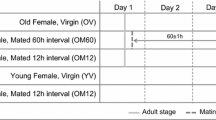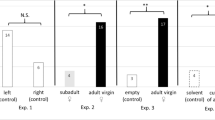Abstract
Bioassays in two sympatric spider species, Tegenaria domestica and T. pagana, demonstrate that the total female chemical extract, and in particular the polar fraction, are involved in the sexual behavior of males and reproductive isolation mechanisms. In T. domestica female attractiveness was correlated with changes in 18 chemical compounds. In T. pagana little difference was observed between 12 compounds in extracts of attractive and unattractive females. 12- + 10-Methyloctacosane was not detected in attractive females of either species. Reproductive isolation was linked not only to quantitative changes in 18 chemical compounds detected in both species, but also to nine compounds present in one or the other species.
Similar content being viewed by others
REFERENCES
AYYAGARI, R. L., and TIETJEN, W. J. 1986. Preliminary isolation of male inhibitory pheromone of the spider Schizocosa ocreata (Araneae, Lycosidae). J. Chem. Ecol. 13:237–243.
BAGNÈRES, A.-G. KILLIAN, A., CLÉMENT, J.-L., and LANGE, C. 1991. Interspecific recognition among termites of the genus Reticulitermes: Evidence for a role for the cuticular hydrocarbons. J. Chem. Ecol. 17:2397–2420.
BLOMQUIST, G. J., and JACKSON, L. L. 1979. Chemistry and biochemistry of insect waxes, pp. 319–345, in R. T. Holman (ed.). Progress in Lipid Research. Pergamon Press, London.
CARLSON, D. A., NELSON, D. R., LANGLEY, P. A., COATES, T. W., DAVIS, T. L., and LEEGWATER-VAN DER LINDEN, M. E. 1984. Contact sex pheromone in the tsetse fly Glossina pallidipes (Austen). Identification and synthesis. J. Chem. Ecol. 10:429–450.
DE RENOBALES, M., NELSON, D. R., and BLOMQUIST, G. J. 1991. Cuticular Lipids, pp. 240–251, in K. Binnington and A. Retnakaran (eds.). Physiology of the Insect Epidermis. CSIRO, Australia.
DUKSTRA, H. 1976. Searching behaviour and tactochemical orientation in males of the wolfspider Pardosa amentata (Cl.) (Araneae, Lycodidae). Proc. K. Ned. Akad. Wet. 79:235–244.
HADLEY, N. F. 1977. Epicuticular lipids of the desert tenebrionid beetle, Eleodes armata: Seasonal and aclimatory effects on composition. Insect Biochem. 7:277–283.
HADLEY, N. F., and HALL, R. L. 1980. Cuticular lipid biosynthesis in the scorpion, Paruroctonus mesaensis. J. Exp. Zool. 212:373–379.
HADLEY, N. F., and JACKSON, L. L. 1977. Chemical composition of the epicuticular lipids of the scorpion. Paruroctonus mesaensis. Insect Biochem. 7:85–89.
HADLEY, N. F., and QUILAN, M. C. 1989. Cuticular permeability of the black widow spider Latrodectus hesperus. Comp. Physiol. Biochem. 159:243–248.
HOWARD, R. W. 1993. Cuticular hydrocarbons and chemical communication, pp. 179–226, in D. W. Stanley-Samuelson and D. R. Nelson (eds.). Insect Lipids. Chemistry, Biochemistry and Biology. University of Nebraska Press, Lincoln.
JACKSON, L. L., and BLOMQUIST, G. J. 1976. Insect waxes, pp. 201–223, in P. E. Kolattukudy (ed.). Chemistry and Biochemistry of Natural Waxes. Elsevier, Amsterdam.
KASTON, B. J. 1936. The senses involved in the courtship of some vagabond spiders. Entomol. Am. 16:97–167.
LOCKEY, K. H. 1980. Insect cuticular hydrocarbons. Comp. Biochem. Physiol. 65:457–462.
LOCKEY, K. H. 1988. Lipids of the insect cuticle: Origin, composition and function. Comp. Biochem. Physiol. 89:595–645.
ROLAND, C. 1984. Chemical signals bound to the silk in spider communication (Arachnida, Araneae). J. Arachnol. 11:309–314.
ROLAND, C., and ROVNER, J. S. 1983. Chemical and vibratory communication in the aquatic pisaurid spider Dolomedes triton (Araneae, Pisauridae). J. Arachnol. 11:77–85.
SCHULZ, S., and TOFT, S. 1993. Identification of a sex pheromone from a spider. Science 260:1635–1637.
STANLEY-SAMUELSON, D. W., and NELSON, D. R. (eds.). 1993. Insect Lipids. Chemistry, Biochemistry and Biology. University of Nebraska Press, Lincoln, 467 pp.
SUTER, R. B., and HIRSCHEIMER, A. J. 1986. Multiple web-borne pheromones in a spider Frontinella pyramitela (Araneae: Linyphiidae). Anim. Behav. 34:748–753.
SUTER, R. B., and RENKES, G. 1982. Linyphiid spider courtship: Releaser and attractant functions of a contact sex pheromone. Anim. Behav. 30:714–718.
TIETJEN, W. J. 1977. Dragline-following by male lycosid spiders. Psyche 84:165–178.
TIETJEN, W. J., and ROVNER, J. S. 1980. Trail-following behaviour in two species of wolf spiders: Sensory and etho-ecological concomitants. Anim. Behav. 28:735–741.
TOOLSON, E. C., and HADLEY, N. F. 1977. Cuticular permeability and epicuticular lipid composition in two Arizona vejovid scorpions. Physiol. Zool. 50:323–330.
TRABALON, M., CAMPAN, M., PORCHERON, P., CLÉMENT, J.-L., BAEHR, J.-C., MORINIERE, M., and JOULIE, C. 1990. Relationships among hormonal changes, cuticular hydrocarbons, and attractiveness during the first gonadotropic cycle of the female Calliphora vomitoria (Diptera). Gen. Comp. Endocrinol. 80:216–222.
TRABALON, M., BAGNÈRES, A.-G., HARTMANN, N., and VALLET, A. 1996. Changes in cuticular compounds composition during the gregarious period and after dispersal of the young in Tegenaria atrica (Araneae, Agelenidae). Insect Biochem. Mol. Biol. 26:77–84.
Rights and permissions
About this article
Cite this article
Trabalon, M., Bagnères, A.G. & Roland, C. Contact Sex Signals in Two Sympatric Spider Species, Tegenaria domestica and Tegenaria pagana . J Chem Ecol 23, 747–758 (1997). https://doi.org/10.1023/B:JOEC.0000006408.60663.db
Issue Date:
DOI: https://doi.org/10.1023/B:JOEC.0000006408.60663.db




